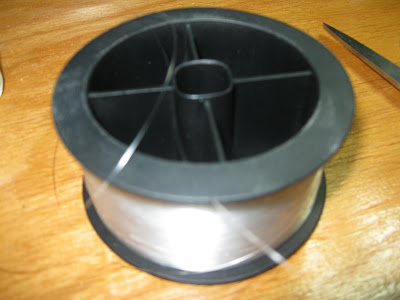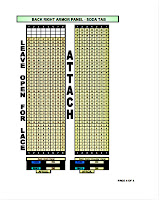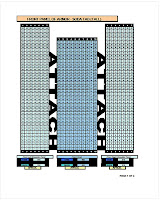(Click on images for larger view)
The mandrel setup is a tool which accommodates a mandrel or metal rod for coiling wire to make metal rings. Below is helpful information and instruction on building your own mandrel setup that can be customized to fit your needs and budget!Mini Winding from an arts and craft store
(some shopping ability-easy)
(some shopping ability-easy)
I have seen this type of coiling setup in arts and craft stores and it is very small. I have never owned one, nor used one so I can't vouch for it's usefulness with certainty. However, I do know that because of the size you will not be able to produce the larger rings or use heavier wire. Also do to the size the coils will not be very long, therefore not many rings will be produced and can become time consuming. The fact that the whole thing looks to be simply made scares me personally. The type of wear and tear that I give my large aluminum mandrel setup, I won't touch an itty-bitty one for fear I would break it in half! But to be fair I do a lot of heavy work on mine, so don't let my personal opinion of something I've never used, stop you. If all you are interested in is a quick and easy way to try your talents at making delicate rings for making jewelry, then this may be a perfect inexpensive setup for you!
Mandrels or Rods for the Mini setup
Unknown
Wooden Setup
(minimal woodworking skill-medium)
(minimal woodworking skill-medium)
You will need: one piece of 2x8 wood about 16" - 24" long, two pieces of 1x8 wood about 8" long, about 4-6 wood screws, and some wood glue.** When you purchase the wood, stores like Lowe's and Home Depot will likely cut it for you to the size you need at a small additional cost.
Using wood glue, add a dab to each end of the board before attaching. Using the wood screws, attach the 1x8 boards to the 2x8 board, one on each end. Holes must be drilled in each of the 1x8 pieces of wood approximately 1” to 1 1/2” from top and center. The holes must be big enough to fit a ½ inch mandrel, and also must line up properly with each other. You have the option on this set up to add additional holes for each rod size for better quality. However, the holes may wear over time due to the rubbing of the metal rods, and another mandrel setup will need to be made.
 Mandrels or Rods for the wooden mandrel setup
Mandrels or Rods for the wooden mandrel setupWith a wooden mandrel setup, metal rods are preferred because they last much longer with no damage.
You can use wooden rods with the understanding that the coils will wear on the wood over time and change the size of the rings and will damage the rod.
 You will need to bend the end of one side of the rod to make a handle (crank) for turning the rod in order to coil the wire. On the opposite end from the handle, leaving room to rest safely in the mandrel set up, drill a hole large enough to insert the wire to start the coiling process.
You will need to bend the end of one side of the rod to make a handle (crank) for turning the rod in order to coil the wire. On the opposite end from the handle, leaving room to rest safely in the mandrel set up, drill a hole large enough to insert the wire to start the coiling process.Rod sizes I use often are 3/8, ¼, 5/16, 1/2”.
(Click on image for larger view)
Aluminum Setup
(welding knowledge necessary-hard)
(welding knowledge necessary-hard)
This is what i use so I will include more pictures to give you a better idea of what it should look like.
 You will need, two 1x2” aluminum pieces approximately 24” long, two 1/4x 6” aluminum plate just shy of 5 3/4” long, four aluminum triangle wedges that are 2” high and 1 3/4” long, cut a ½” length piece off of a 2” diameter aluminum pipe, and a very skilled brother-n-law to weld it together for you like mine, thanks Mike!
You will need, two 1x2” aluminum pieces approximately 24” long, two 1/4x 6” aluminum plate just shy of 5 3/4” long, four aluminum triangle wedges that are 2” high and 1 3/4” long, cut a ½” length piece off of a 2” diameter aluminum pipe, and a very skilled brother-n-law to weld it together for you like mine, thanks Mike! You will need to line up the two 1x2” evenly to the outside edges of the 1/4x6” and weld. There should be a gap between the two 1x2” down the center. Drill a hole in each 1/4x6” plate approximately 1 1/2” from top centered. The hole should be just shy of 3/4” in diameter. Weld the aluminum triangle wedges for additional structure strength. This was meant to last FOREVER!
You will need to line up the two 1x2” evenly to the outside edges of the 1/4x6” and weld. There should be a gap between the two 1x2” down the center. Drill a hole in each 1/4x6” plate approximately 1 1/2” from top centered. The hole should be just shy of 3/4” in diameter. Weld the aluminum triangle wedges for additional structure strength. This was meant to last FOREVER! For hand drill attachment sand down around one of the holes on the 1/4x6” plate. The sanding should make a slope effect towards the hole, where as around the hole should be thinner and it should slop outwards 2” in diameter. Weld the 2” pipe piece to the outside of the sanded 1/4x6” plate, centering it around the hole. The pipe piece should stick out approximately 1/2” from the plate. This should help stabilize the hand drill but some grinding may occur. You will need to disassemble the hand drill and attach it into the mandrel setup. You may need to sand more, or add a new longer bolt, replacing the one that comes with the drill to make it fit securely. There will be some slight wobbling until a metal rod has been inserted ready to coil. The turning of the crank makes this the most smoothest tool to use and is easy on the hands. I have wore out one hand drill over time where it attaches to the rods. All I had to do was disassemble it, buy a new one and replace. I kept the old wore out drill for some of the spare parts that are still useable. I love it!
For hand drill attachment sand down around one of the holes on the 1/4x6” plate. The sanding should make a slope effect towards the hole, where as around the hole should be thinner and it should slop outwards 2” in diameter. Weld the 2” pipe piece to the outside of the sanded 1/4x6” plate, centering it around the hole. The pipe piece should stick out approximately 1/2” from the plate. This should help stabilize the hand drill but some grinding may occur. You will need to disassemble the hand drill and attach it into the mandrel setup. You may need to sand more, or add a new longer bolt, replacing the one that comes with the drill to make it fit securely. There will be some slight wobbling until a metal rod has been inserted ready to coil. The turning of the crank makes this the most smoothest tool to use and is easy on the hands. I have wore out one hand drill over time where it attaches to the rods. All I had to do was disassemble it, buy a new one and replace. I kept the old wore out drill for some of the spare parts that are still useable. I love it! Mandrels or Rods for the metal mandrel setup
Mandrels or Rods for the metal mandrel setupMetal rods are always preferred because they last much longer with no damage.
You can use wooden rods with the understanding that the coils will wear on the wood over time and change the size of the rings and will damage the rod.
 If you've added the hand drill, then all you need to do is drill a hole on one side of the rod to insert the wire for coiling. Leave enough room to insert the rod into the hand drill before drilling the hole for the wire.
If you've added the hand drill, then all you need to do is drill a hole on one side of the rod to insert the wire for coiling. Leave enough room to insert the rod into the hand drill before drilling the hole for the wire. If you don't add the hand drill, you will need to bend the end of one side of the rod to make a handle (crank) for turning the rod in order to coil the wire. On the opposite end from the handle, leaving room to rest safely in the mandrel set up, drill a hole large enough to insert the wire to start the coiling process.
If you don't add the hand drill, you will need to bend the end of one side of the rod to make a handle (crank) for turning the rod in order to coil the wire. On the opposite end from the handle, leaving room to rest safely in the mandrel set up, drill a hole large enough to insert the wire to start the coiling process.Rod sizes I use often are 3/8, ¼, 5/16, 1/2”.
** It is a good idea to clamp or bolt the mandrel setup down to a workbench, a desk, or table so that it doesn't move around when you are coiling wire. Clamps can be found at any hardware store.









































